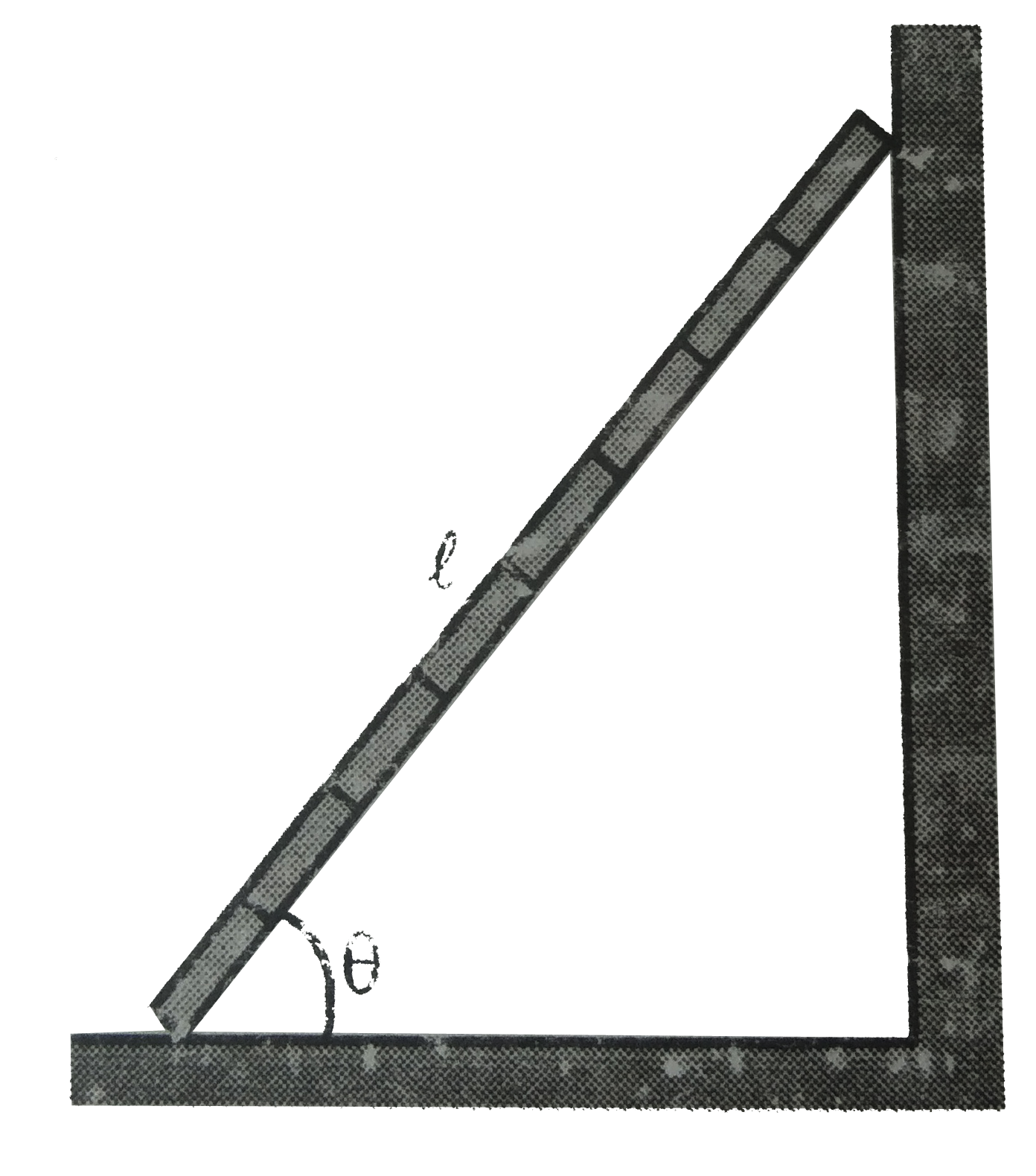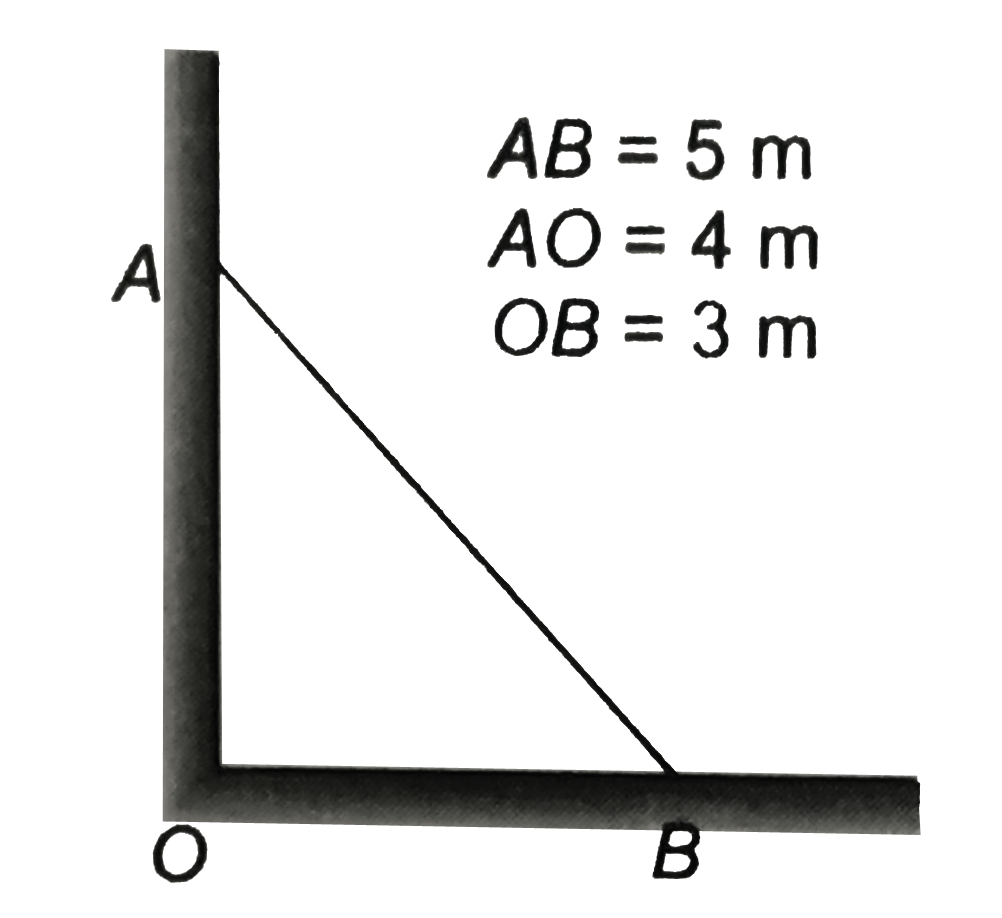A uniform ladder of length 3.25 m and weight 250 N is placed against a smooth vertical wall with its lower end 1.25 m from the wall. If coefficient of friction between the ladder and the floor is 0.3, then, find the frictional force acting on the ladder at the point of contact between ladder and floor.
To solve the problem of finding the frictional force acting on a ladder leaning against a smooth wall, we will follow these steps:
Step 1: Understand the System
We have a uniform ladder of length L=3.25m and weight W=250N. The ladder is placed against a smooth vertical wall, with its lower end d=1.25m away from the wall. The coefficient of friction between the ladder and the floor is μ=0.3.
Step 2: Identify Forces Acting on the Ladder
1. Weight of the Ladder (W): Acts downward at the center of the ladder.
2. Normal Force from the Ground (N1): Acts upward at the base of the ladder.
3. Normal Force from the Wall (N2): Acts horizontally at the point of contact with the wall.
4. Frictional Force (F): Acts horizontally at the base of the ladder, opposing the motion.
Step 3: Apply Vertical Force Equilibrium
In the vertical direction, the forces must balance:
N1=W
Thus,
N1=250N
Step 4: Apply Torque Equilibrium
To find the normal force from the wall (N2), we can take moments about the point where the ladder contacts the ground (point A). The ladder is in rotational equilibrium, so the sum of torques about this point must be zero.
The torque due to the weight of the ladder (acting at its midpoint) is:
τW=W⋅(L2⋅cos(θ))
The torque due to the normal force from the wall is:
τN=N2⋅(L⋅sin(θ))
Setting the torques equal gives:
W⋅(L2⋅cos(θ))=N2⋅(L⋅sin(θ))
Step 5: Simplify the Torque Equation
Cancelling L from both sides:
W2⋅cos(θ)=N2⋅sin(θ)
Rearranging gives:
N2=W⋅cos(θ)2⋅sin(θ)
Step 6: Find tan(θ)
Using Pythagoras' theorem, we can find θ:
Height=√(L2−d2)=√(3.252−1.252)=√(10.5625−1.5625)=√9=3m
Thus,
tan(θ)=Heightd=31.25=2.4
Step 7: Calculate N2
Now substituting W=250N and tan(θ):
N2=250⋅cos(θ)2⋅sin(θ)=250⋅1√1+(2.4)22⋅2.4√1+(2.4)2
This simplifies to:
N2=2502⋅2.4=2504.8≈52.08N
Step 8: Find Frictional Force
The frictional force F is equal to the normal force from the wall:
F=N2≈52.08N
Step 9: Check Maximum Friction
The maximum friction force is given by:
Fmax=μ⋅N1=0.3⋅250=75N
Since F<Fmax, the ladder does not slip.
Final Answer
The frictional force acting on the ladder at the point of contact between the ladder and the floor is approximately 52.08N.
---
We have a uniform ladder of length L=3.25m and weight W=250N. The ladder is placed against a smooth vertical wall, with its lower end d=1.25m away from the wall. The coefficient of friction between the ladder and the floor is μ=0.3.
1. Weight of the Ladder (W): Acts downward at the center of the ladder.
2. Normal Force from the Ground (N1): Acts upward at the base of the ladder.
3. Normal Force from the Wall (N2): Acts horizontally at the point of contact with the wall.
4. Frictional Force (F): Acts horizontally at the base of the ladder, opposing the motion.
In the vertical direction, the forces must balance:
N1=W
Thus,
N1=250N
To find the normal force from the wall (N2), we can take moments about the point where the ladder contacts the ground (point A). The ladder is in rotational equilibrium, so the sum of torques about this point must be zero.
τW=W⋅(L2⋅cos(θ))
The torque due to the normal force from the wall is:
τN=N2⋅(L⋅sin(θ))
W⋅(L2⋅cos(θ))=N2⋅(L⋅sin(θ))
Cancelling L from both sides:
W2⋅cos(θ)=N2⋅sin(θ)
Rearranging gives:
N2=W⋅cos(θ)2⋅sin(θ)
Using Pythagoras' theorem, we can find θ:
Height=√(L2−d2)=√(3.252−1.252)=√(10.5625−1.5625)=√9=3m
Thus,
tan(θ)=Heightd=31.25=2.4
Now substituting W=250N and tan(θ):
N2=250⋅cos(θ)2⋅sin(θ)=250⋅1√1+(2.4)22⋅2.4√1+(2.4)2
This simplifies to:
N2=2502⋅2.4=2504.8≈52.08N
The frictional force F is equal to the normal force from the wall:
F=N2≈52.08N
The maximum friction force is given by:
Fmax=μ⋅N1=0.3⋅250=75N
Since F<Fmax, the ladder does not slip.
The frictional force acting on the ladder at the point of contact between the ladder and the floor is approximately 52.08N.
Topper's Solved these Questions
- SYSTEM OF PARTICLES AND ROTATIONAL MOTIONBOOK - AAKASH INSTITUTECHAPTER - SYSTEM OF PARTICLES AND ROTATIONAL MOTIONEXERCISE - Assignment (Section - J) Aakash Challengers Questions
13 Videos
- SEMICONDUCTOR ELECTRONICS: MATERIALS, DEVICES AND SIMPLE CIRCUITSBOOK - AAKASH INSTITUTECHAPTER - SEMICONDUCTOR ELECTRONICS: MATERIALS, DEVICES AND SIMPLE CIRCUITSEXERCISE - Assignment (Section-D (Assertion and reason))
5 Videos
- TEST 1BOOK - AAKASH INSTITUTECHAPTER - TEST 1EXERCISE - EXERCISE
9 Videos
Similar Questions
A uniform ladder of length l rests against a smooth, vertical wall (figure). If the mass of the ladder is m and the the coefficient of static friction between the ladder and the ground is μs=0.375 and the minimum angle θmin at which the ladder does not slip.

A uniform ladder at rest, leading against a smooth wall. Th ground is rough.
View SolutionA ladder wighing 300 N is placed against a smooth vertical wall having a coefficient of friction between it and the floor of 0.2. What is the maximum force of friction available at the point of contact between the ladder and the floor?
View Solution
Knowledge Check
If a ladder weighting 250N in placed a smooth vartical wall having coefficient of friction between it and floor 03, then what is the maximum force of fraction available at the point of contact between the ladder and the floor?
A75NB50NC35ND25NIf a lodder weighing 250 N is placed against a smooth vertical wall having coefficient of friction between it and floor is 0.3 then what is the maximum force of friction available at the point of contact between the lodder and the floor?
A75NB50NC35ND25NIf a lodder weighing 250 N is placed against a smooth vertical wall having coefficient of friction between it and floor is 0.3 then what is the maximum force of friction available at the point of contact between the lodder and the floor?
A75NB50NC35ND25N
A ladder of length l and mass m is placed against a smooth vertical wall, but the ground is not smooth. Coefficient of friction between the ground and the ladder is μ. The angle θ at which the ladder will stay in equilibrium is
View SolutionA uniform ladder 5.0m long rests against a frictionless, vertical wall with its lower end 3.0m to from the wall. The ladder weighs 160N. The coefficient of static friction between the foot of the ladder and the ground is 0.40. A man weighing 740N climbs slowly up the ladder.
What is the maximum frictional force that the ground can exert on the ladder at its lower end?
View SolutionA uniform ladder 5.0m long rests against a frictionless, vertical wall with its lower end 3.0m to from the wall. The ladder weighs 160N. The coefficient of static friction between the foot of the ladder and the ground is 0.40. A man weighing 740N climbs slowly up the ladder.
What is the actual frictional force when the man has climbed 1.0m along the ladder?
View SolutionA ladder of length 5m is placed against a smooth wall as shown in figure. The coefficient or friction is μ between ladder and ground. What is the minimum value of μ , If the ladder is not to slip?

View SolutionA uniform ladder 5.0m long rests against a frictionless, vertical wall with its lower end 3.0m to from the wall. The ladder weighs 160N. The coefficient of static friction between the foot of the ladder and the ground is 0.40. A man weighing 740N climbs slowly up the ladder.
How far along the ladder can the man climb before the ladder starts to slip?
View Solution
